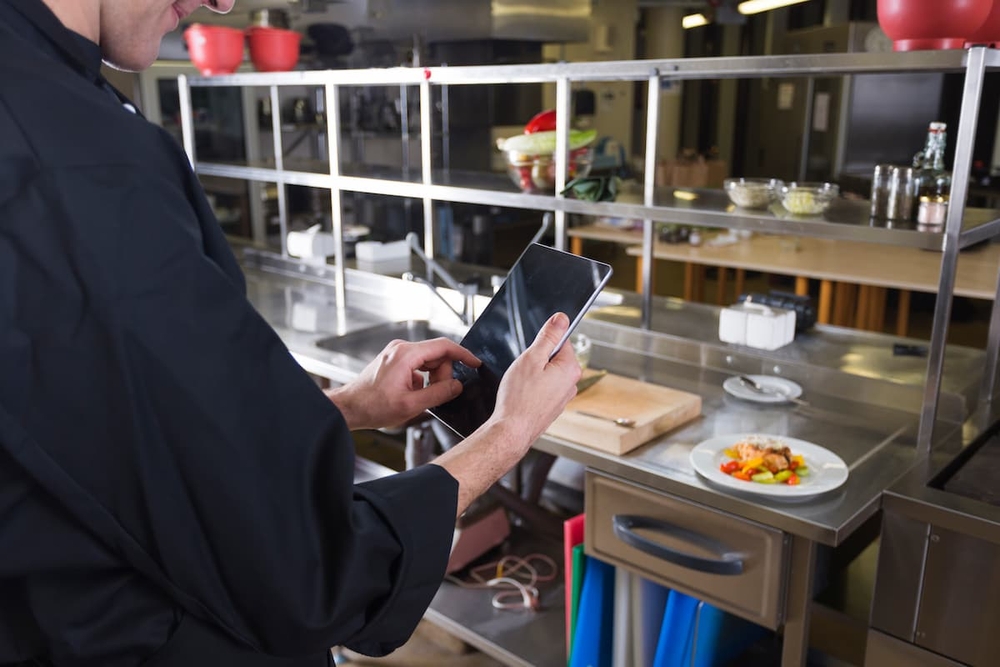What a HACCP plan for commercial kitchens means and how to implement it
Table of Contents
CloudKitchens
How many tacos can be delivered from a 1000sqft restaurant?
The same amount as a 200sqft ghost kitchen.
Food safety is the backbone of every successful commercial kitchen. Whether you operate a bustling restaurant, a ghost kitchen, or a multi-unit foodservice operation, ensuring the safety of your food products is non-negotiable. One of the most effective and internationally recognized systems for managing food safety hazards is the Hazard Analysis and Critical Control Point (HACCP) plan.
But what exactly is a HACCP plan for commercial kitchens, why is it essential, and how can you develop and implement one that keeps your customers safe and your business compliant?
What is a HACCP plan for commercial kitchens?
A HACCP plan for commercial kitchens is a systematic, preventive approach to food safety. It identifies, evaluates, and controls hazards-biological, chemical, and physical-throughout the food production process.
The HACCP Plan details every step your kitchen will take to guarantee food safety, from ingredient sourcing to final service. It is required by law for certain food businesses and is highly recommended for all commercial kitchens.
Unlike reactive food safety measures, HACCP proactively prevents hazards before they can cause harm, making it the gold standard for food safety in restaurants, dark kitchens, and food service operations.
Read more: Ensuring compliance: health and safety regulations for ghost kitchens
Why is a HACCP plan important for commercial kitchens?
A HACCP plan is critically important for commercial kitchens because it serves as both a legal requirement and a cornerstone of effective food safety management. Here’s a more detailed look at why it matters:
Regulatory Compliance
Many health departments and food safety authorities mandate that food businesses implement a HACCP-based system. This requirement is rooted in laws and codes of practice designed to protect public health.
Regulatory agencies may review your HACCP plan and records during inspections, and failure to comply can result in penalties, closures, or loss of business licenses. Having a HACCP plan ensures your kitchen meets these legal obligations and stays operational.
Risk Reduction
A HACCP plan systematically identifies, evaluates, and controls food safety hazards-biological (like bacteria and viruses), chemical (such as cleaning agents or allergens), and physical (like glass or metal fragments).
By focusing on prevention rather than just end-product testing, HACCP helps reduce the risk of foodborne illnesses and contamination at every stage of food production. This proactive approach is far more effective than relying on inspections alone.
Customer Confidence:
When customers know your business follows a HACCP plan, it signals a strong commitment to food safety and quality. This builds trust, encourages repeat business, and enhances your reputation in a competitive market. Many commercial clients and partners also require suppliers to be HACCP-compliant as a prerequisite for doing business.
Operational Efficiency:
Implementing a HACCP plan streamlines kitchen processes by clearly defining critical control points, monitoring procedures, and corrective actions. This clarity reduces waste, minimizes errors, and ensures that staff are well-trained and accountable for food safety tasks. Efficient operations not only improve safety but also contribute to cost savings and smoother service.
In summary, a HACCP plan is essential in commercial kitchens because it ensures legal compliance, reduces health risks, builds customer trust, and drives operational excellence-all of which are fundamental for a successful food business.
Read more: 6 Licenses and permits needed to open a restaurant
The 7 principles of HACCP in commercial kitchens
The HACCP system is built on seven core principles. Understanding and applying these principles is essential for creating an effective food safety program.
| Principle | Description |
| 1. Conduct a hazard analysis | Identify potential hazards (biological, chemical, physical) at each stage of food production. |
| 2. Determine critical control points (CCPs) | Pinpoint steps where hazards can be prevented, eliminated, or reduced to safe levels. |
| 3. Establish critical limits | Set measurable safety thresholds (e.g., temperature, pH, time) for each CCP. |
| 4. Establish monitoring procedures | Define how and when you will check that critical limits are met. |
| 5. Establish corrective actions | Outline steps to take if a critical limit is not met. |
| 6. Establish verification procedures | Confirm that the HACCP system is working as intended. |
| 7. Establish record-keeping and documentation procedures | Maintain accurate records of all HACCP-related activities. |
Step-by-step: How to write a HACCP plan for a commercial kitchen
Writing a HACCP plan may seem daunting, but breaking it down into clear steps makes the process manageable. Here’s a detailed guide based on industry best practices and regulatory guidelines:
1. Assemble your HACCP team
Gather a multidisciplinary team with expertise in food safety, kitchen operations, and your specific menu. Include chefs, managers, and staff responsible for food handling. Training in HACCP principles is recommended for all team members.
2. Describe your food products and intended use
List all menu items, ingredients, and their intended use (e.g., ready-to-eat, cooked, chilled). Identify the target consumers, such as the general public or vulnerable populations like children or the elderly.
3. Develop a process flow diagram
Create a detailed flow chart that maps every step in your food production process-from receiving and storage to preparation, cooking, holding, and service. This visual tool helps identify where hazards may occur.
4. Verify the process flow diagram
Walk through your kitchen to confirm the accuracy of the flow diagram. Make sure all steps and processes are included and in the correct order.
5. Conduct a hazard analysis (Principle 1)
Identify and evaluate potential hazards at each step in your process. Consider:
- Biological hazards: Bacteria, viruses, parasites (e.g., Salmonella, E. coli)
- Chemical hazards: Cleaning agents, allergens, pesticides
- Physical hazards: Glass, metal, plastic, hair
Assess the likelihood and severity of each hazard, and determine which ones require control.
Read more: Common health code violations in restaurants and how to fix them
6. Determine critical control points (CCPs) (Principle 2)
Identify the steps where you can apply controls to prevent, eliminate, or reduce hazards to safe levels. Common CCPs include cooking, cooling, and holding temperatures.
7. Establish critical limits (Principle 3)
Set measurable limits for each CCP. Examples:
- Minimum internal cooking temperature for chicken: 165°F (74°C)
- Maximum time food can be held at room temperature: 2 hours
Critical limits must be observable and based on scientific guidelines.
8. Establish monitoring procedures (Principle 4)
Define how you will monitor each CCP. This could involve temperature checks, visual inspections, or chemical tests. Assign responsibility for monitoring and specify how often checks will occur.
9. Establish corrective actions (Principle 5)
Specify what actions to take if a critical limit is not met. For example, if cooked food does not reach the required temperature, continue cooking until it does, or discard the food if safety cannot be assured.
10. Establish verification procedures (Principle 6)
Regularly review and verify that your HACCP plan is working. This may include internal audits, equipment calibration, and reviewing monitoring records.
11. Establish record-keeping and documentation procedures (Principle 7)
Maintain detailed records of hazard analyses, CCP monitoring, corrective actions, verification activities, and staff training. Accurate documentation is essential for inspections and continuous improvement.
Read more: What are ghost kitchens? The definitive guide to virtual restaurants
How is HACCP used in a commercial kitchen?
In a commercial kitchen, HACCP is used to systematically assess every part of the food preparation and handling process. This includes receiving ingredients, storage, preparation, cooking, cooling, holding, and serving. At each step, potential hazards are identified and controls are put in place to prevent contamination or unsafe conditions.
For example:
- Receiving: Inspecting deliveries for spoilage or contamination.
- Storage: Monitoring refrigerator and freezer temperatures.
- Preparation: Preventing cross-contamination between raw and cooked foods.
- Cooking: Ensuring foods reach safe internal temperatures.
- Holding: Keeping hot foods above and cold foods below critical temperatures.
Practical tips for HACCP implementation in commercial kitchens
- Digital solutions: Use digital HACCP tools for automated temperature monitoring, task management, and real-time reporting. These systems reduce paperwork and human error, making compliance easier and more reliable.
- Staff training: Regularly train all staff on food safety protocols, personal hygiene, and HACCP procedures. Well-trained teams are your first line of defense against food safety hazards.
- Supplier verification: Work with reputable suppliers who follow strict food safety standards. Verify their certifications and quality control measures.
- Routine cleaning and maintenance: Implement scheduled cleaning and equipment maintenance to prevent contamination and ensure smooth operations.
- Quality control and traceability: Label and date all food items, use the FIFO (First In, First Out) method, and maintain traceability for quick recalls if needed.
Read more: Kitchen Hygiene: rules and good practices to apply in your kitchen
How CloudKitchens supports your HACCP plan for commercial kitchens
CloudKitchens is committed to helping food businesses of all sizes achieve the highest standards of food safety and operational efficiency. By partnering with CloudKitchens, you gain access to state-of-the-art facilities, digital tools, and expert support-empowering you to build a safer, more efficient, and more successful commercial kitchen operation.
Contact CloudKitchens today to discover how we can help you achieve food safety excellence and streamline your kitchen’s compliance and operations.
DISCLAIMER: This information is provided for general informational purposes only and the content does not constitute an endorsement. CloudKitchens does not warrant the accuracy or completeness of any information, text, images/graphics, links, or other content contained within the blog content. We recommend that you consult with financial, legal, and business professionals for advice specific to your situation.
More insights & stories
There’s more where that came from.
Get in the know and check out our additional insights


